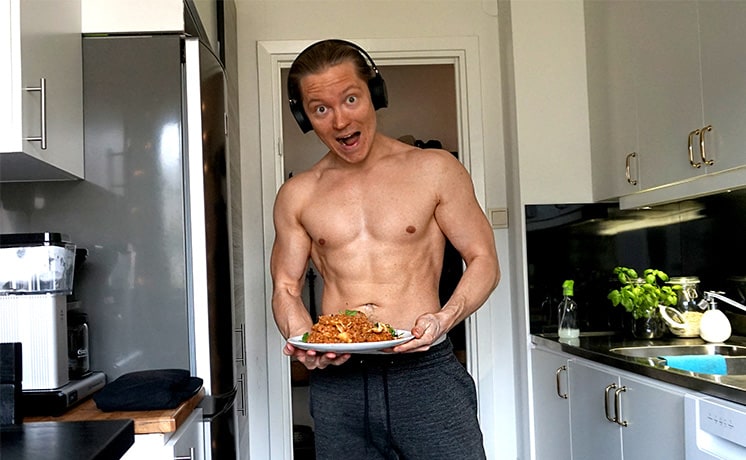
One question I get often is whether or not intermittent fasting is a good idea for someone starting out as skinny fat.
Personally I started with the skinny fat physique and I’ve also been using intermittent fasting for over four years by now. So, I think I have enough experience with intermittent fasting and how it can help you as a skinny fat individual. So, that’s what we’re going to look at in this post.
Okay so how is it? Is intermittent fasting good for a skinny fat individual? Yes, intermittent fasting is a very good tool for most skinny fat individuals. The biggest problem a skinny fat guy has is gaining fat easily while struggling with muscle growth. IF helps with both fat loss and lean muscle growth by improving food control.
Intermittent fasting isn’t a magic bullet for fat loss and muscle growth like so many people think, but it still works extremely well for most people nonetheless. In this post I’ll discuss why IF works so well for skinny fat guys and how you can set it up to get the best results possible.
Table of Contents
What is Intermittent Fasting?
Before looking at why intermittent fasting works well for skinny fat individuals let’s first discuss what IF is.
Intermittent fasting is simply a dieting strategy where you schedule fasts during certain times of the day(s) to promote fat loss. The most commonly used IF schedule is The 16:8 Leangains Method created by Martin Berkhan.
The Leangains Method 16:8
This IF method was created by Swedish nutrition expert and personal trainer Martin Berkhan who has an amazing physique and have helped a ton of people get downright ripped partly with the use of intermittent fasting.
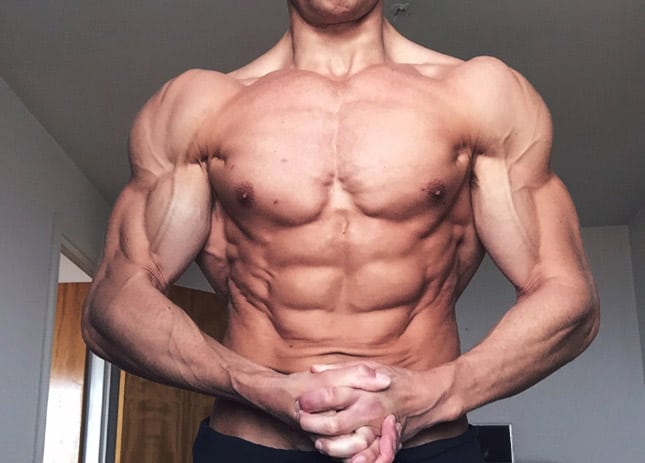
His method suggests that you fast for 16 hours of the day and eat for the remaining 8 hours. Usually the fast takes place over the night and morning and then food is allowed during the day and through the evening.
During the fast you can only consume water, black coffee, non-sweetened tea or other non-sweetened beverages. You can also have a VERY small snack up to 50-70 calories depending on your body size.
Now, a 16 hour fast might sound like a lot, but it’s not. If you get the nights hours with you, all you must do is skip breakfast and eat a bigger lunch and dinner instead. This is the method I used in the beginning of my fitness journey and my typical schedule looked like this:
- 1-2 PM: Started eating window
- 9-10 PM: Started fasting window
So, basically I skipped breakfast and morning snack and went straight for lunch instead. It was very simple and worked extremely well for my appetite, here’s a quick backstory of how fasting helped me get downright ripped:
How I Went From Skinny Fat to Ripped Using Intermittent Fasting

Before I fell in love with fitness and physique development back in 2014, I used to live very unhealthy and had no real food habits. Some days I had a little breakfast, some days I fasted without “calling” it fasting. But what I can remember is that I never had much of an appetite in the morning.
When I started working out with the goal to get lean and muscular, I followed the typical advice of eating from the moment I woke up, and then 6 meals per day, every 3 hours, because that was what I was told to do.
In fact, if I didn’t eat breakfast or have a meal every 3 hours, supposedly my metabolism would slow down, and I would start “saving” fat and burn muscles. At that time it sounded so correct and even smart, as I thought to myself:
“Of course skipping breakfast or not eating every 3 hours would slow down my metabolism, the body is “smart” and when it doesn’t have nutrients available it will start to save the fat and burn the muscles instead…”
So, I stuck with eating breakfast and 6 tiny meals per day for a while, even though both me and my body hated that way of eating. Fortunately, at least some of the information that I used was correct, which was that I needed to be in a calorie deficit to lose body fat.
So indeed, I managed to lose some fat. But only at first… It didn’t take long until I started to struggle, and boy did I struggle…
You see, since fat loss is all about calories in vs calories out, I started to get extremely hungry during the evenings and nights. The reason for this was that at 6 pm I had already used up 80 % of my calories that I could eat during the day if I wanted to maintain a calorie deficit in order to lose body fat, and I went to bed at around 10-11 pm.
For me that meant I had a puny meal of 400 calories 4-5 hours before going to sleep.
I can remember how I couldn’t sleep, and that some nights I said fuck it, and tried to sleep anyways, just to wake up the next morning feeling like I hadn’t slept at all… You know the feeling right? When the night passes by, but you question whether you even slept at all…
Other nights I just had to eat something even though I was supposed to be in a calorie deficit. What this did was offset most of the deficit that I was supposed to have in order to lose fat. And because of that I just didn’t care, instead I ate it all, which typically turned into a total binge fest for a few days.
Furthermore, during the days every meal felt so small that I was constantly hungry and never satisfied, it just sucked less during the days, than during the nights.
So, as you can see, I was stuck not getting the physique that I wanted, I felt weak, tired and actually more out of shape:

How I looked after a couple of months dieting with 6 small meals per day
I had to do something else, I thought, there has to be another way! So, that’s when I started to search for real solid and true information online.
After all, if you seek you should find, right? And that’s exactly what I did when I stared following Radu Antoniu’s videos and blog posts over at thinkeatlift.com which eventually led me to buy his ShredSmart program, which I now can’t recommend enough.
I started to learn that it’s the total calories and macros that you eat during the day that matters, not when they are eaten. I also learned that having to eat every 3 hours is just a myth, and so is having to eat breakfast.
The truth is that the body has systems in place to make us able to fast for long times while still being able to perform well, maintain muscle and allow us to feel good.
This was when everything surrounding the diet totally changed for me. I could skip breakfast, at a time when I wasn’t all that hungry anyways.
I could have a smaller meal at lunch and then have tons of food left in the afternoon and evenings which allowed me to feel extremely full and satisfied at the time when I needed it the most, all while I lost the fat I wanted and got down to around 10-12 % body fat.
Actually, I remember how my fat dropped like it was nothing. My sleep also improved and I felt stronger and more capable again, all while getting leaner and more muscular:
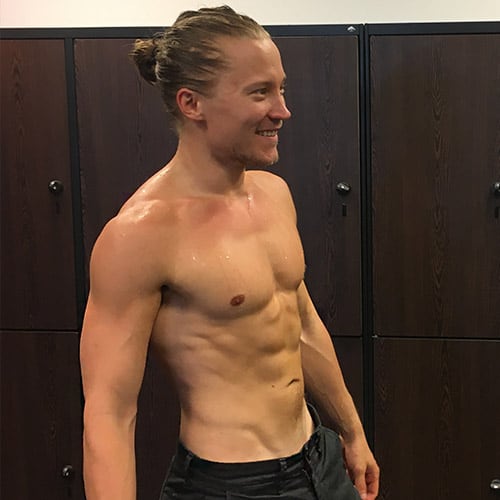
How I looked after another few months of dieting with 3 big intermittent fasting meals per day
The bottom line with this story is that intermittent fasting works very well for most people with a big appetite and who also stores body fat easily, but have a hard time gaining muscle, i.e skinny fat.
How Intermittent Fasting Helps With Fat Loss
Now, we must still remember that intermittent fasting is “just” a tool for fat loss. Meaning that the way IF helps you lose body fat is by making it easier to stay in a calorie deficit.
On that note, here’s the hierarchy of importance for fat loss:
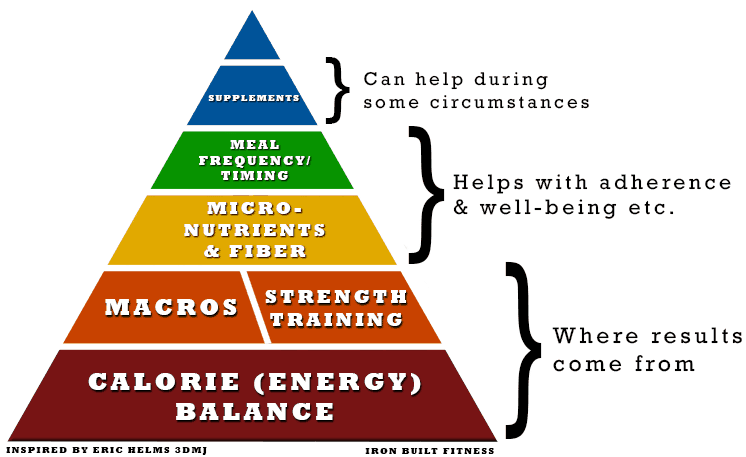
As you can see, meal frequency and timing, basically what intermittent fasting is, is placed fifth in the order of importance. For long-term fat loss to occur you must first make sure you’re:
- In a calorie deficit
- Eat the correct macros (mainly protein)
- Strength train to preserve and build muscle mass
- Eat enough micronutrients and fiber to support long-term well-being and fat loss
After these four are in place only then intermittent fasting is effective, by making the whole diet easier. So, what I’m getting at here is that intermittent fasting doesn’t burn fat in and of itself, it simply makes the other factors easier to adhere and stick to long-term.
Why Intermittent Fasting Works Well For Skinny Fat Individuals
As I wrote earlier, the biggest reason why intermittent fasting works well for skinny fat individuals is because we 1) have a big appetite, 2) store body fat easily and 3) have a harder time gaining muscle.
And if you want to build a lean and muscular physique starting out as skinny fat, you have two main tasks:
- Lose body fat
- Gain muscle
You must get both of these in place to look like this:

But, if you can’t control your appetite then losing body fat will become extremely hard during your cutting phase. And so will staying lean when you’re bulking up to build muscle a well.
And this is where intermittent fasting comes into the picture. By postponing your first meal 4-6 hours into the day you can save up on a huge calorie budget for later in the day, where it’s been shown that people are usually more hungry.
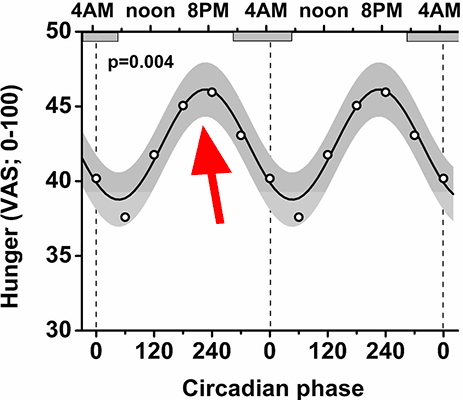
Research on circadian rhythm and hunger. Where the arrow points in this scientific graph, is when during our circadian rhythm that people normally are most hungry. Right around 8 PM in the evening!
So, by postponing most of your food to this time you create a large budget of calories that’s free to eat at this point. You no longer have to work against your willpower to hold back on your calorie intake to the same extent.
In other words, intermittent fasting is an incredible tool for satisfying your appetite without you overeating on calories, simply because you buffered the calories for later in the day.
But, won’t I be hungry during the mornings?
As the research on circadian rhythm shows, hunger and appetite is at the lowest in the morning for most people.
So, by saving those morning (and possibly lunch) calories for the evening, you allow yourself to be more in line with your body while you’re trying to lose fat.
And what happens when you’re in line with your body?
Yes, that’s right, fat loss becomes super duper easy!
But now you might say:
I’m always hungry in the morning, why is that? Can I still use intermittent fasting?
Well, first of all, some people doesn’t have the same circadian rhythm as the one seen in the research above. No, some people simply are more hungry during the mornings.
If this is the case for you, then intermittent fasting in the traditional sense of skipping breakfast, might not be the right choice for you.
With that said though, you could flip the approach and eat more in the morning and just start your fast in the early evening instead. This could however be troublesome for the social aspect of dieting, where you must stop eating food at a time where food is usually in focus. However, it is still a possible strategy to try if you’re hungry in the morning.
Now, a more likely reason why you feel hunger during the morning, is simply because you’re used to eating in the morning.
Research has shown that the hunger hormone Ghrelin is associated with habits. Where more Ghrelin get released when the body is used to eat.
So, it takes somewhere between 1-4 weeks, depending on the individual, to get used to intermittent fasting.
After this “getting used to” time, and especially with the help of these 8 tricks, most individuals can then take advantage of the amazing benefits of intermittent fasting that I’ve written extensively about in this post.
Flexible Fasting: My Preferred Intermittent Fasting Schedule
Finally, I want to show you the intermittent fasting schedule I’m using currently that I believe works very well.
When I started my fitness journey I used the 16:8 schedule which is a fine protocol to use. However, I quickly realized that I wanted more freedom with my dieting.
Personally I hate restrictions and do the most I can to avoid them. So, what I wanted to improve with the 16:8 schedule was to allow for more flexibility. I did this by not setting a strict time at night where I had to stop eat, nor a strict time at midday when I had to start eat.
Instead I always make sure that I postpone my first meal of the day 4-6 hours, sometimes up to 8 hours depending on how I feel, and by doing so I stop eat when I want at night.
This further decreases how much I must depend on willpower.
Having to stop eat at say 8 or 9 PM just because the schedule says so, is incredibly hard in our culture today. The evenings is the time when most of us enjoy food with family and friends. So, allowing myself to eat as late as I want completely removes the stress of having to resist food while everyone else is eating.
For me it makes a lot more sense just skipping food for as long as I feel is possible during the morning and day instead. At this time I’m usually on the move making things happen anyways and are not thinking about food.
So, here’s an outline of the whole Flexible Fasting Schedule that I use and recommend:
The Flexible Fasting Schedule
1. Postpone Your First Meal At Least 4-6 Hours After Waking Up
You don’t have to break your fast at the same time every night. What’s most important is that you try to fast for as long as you feel is appropriate based on how your day looks and how you feel.
Ideally you should aim to postpone your first meal 4-6 hours after you wake up. What this does is making the already easy method intermittent fasting even easier because you have to depend less on willpower.
2. Drink a Few Large Glasses of Water
This is the first intermittent fasting trick that’ll make your fast feel extremely easy. In fact, it’s very common that the body mistakes hunger for thirst.
So, drinking water is crucial, especially during the fast. You should make sure you get at least 2-3 large glasses of water in during your fasted period.
3. Drink 1-2 Cups of Coffee During the Fast
The second trick is to drink a couple cups of black coffee without sugar or milk during the fast.
Caffeine is shown to be a strong appetite suppressant.
However, stick to two, maybe three caffeinated beverages max per day, otherwise, you’ll build up a tolerance for caffeine and both the hunger reducing effects and alertness effects of caffeine will diminish.
4. Move Around
The third trick would be to move around or stay physically active during your fast.
First of all what this will do is keep your mind off of food. But, secondly and more importantly it will make you feel better.
One of the potential drawbacks of fasting especially before you get used to it, is that you might experience brain fog, light headaches and dizziness. Luckily, staying physically active during the fast typically removes these side effects completely.
This seems to be because the elevated levels of stress hormones such as cortisol, adrenaline, noradrenaline and HGH that you will have as a response to not eating, actually wants you to move around. Which explains the basics of our physiological nature, that we need to move in order to seek out and hunt food.
5. Eat a Fruit
This trick should be used if you really feel that you need to eat something. Sure, you’ll break the fast, but only with very few and satiating calories.
I learned about this strategy from Greg over at kinobody.com at it works very well. I use the strategic fruit during times when I’m getting very lean and usually do so to postpone the first meal for another couple of hours.
The reason why the fruit strategy works, is because it replenishes some of the emptied liver glycogen caused by not eating for several hours. What this does is signaling your brain that there’s enough liver glycogen to fuel the body for another few hours. Which then blunts some of your appetite.
Just make sure to count the fruit into your daily caloric intake and you’ll be alright.
6. Have 3-4 Meals During the Second Half of the Day and Eat as Late as You Want
This is your eating window, where you’re allowed to eat as late as you want in the evening because it’s followed by a 15-17 hour long fast!
Feel free to experiment with how you want your meals to be set up for yourself. The way I choose to eat most of the time is this:
-Between 1-2 PM: I have my First meal of the day which typically contains around 30 % of my total calories
-Between 5-7 PM: I have my second meal of the day, which is my feast, and typically contains around 40-50 % of my total calories. This is the meal that actually makes you feel like a god, trust me!
-Between 9-11 PM: I have my final meal of the day, which typically contains around 20-30 % of my total calories.
7. Experiment How You Want Your Macros to Spread Out
With time, you will learn how to enjoy your intermittent fasting schedule more and more. It took me about a year before I found which eating pattern I liked the most, and it’s this one:
-In my first meal: I eat protein and fruits or vegetables. This gives me medium amounts of protein, medium amounts of fiber, low amounts of carbs and low amounts of fat.
-In my second meal: Which are my largest, I eat all the nutrients, protein, carbs, fats and fiber. This gives me large amounts of protein, medium amounts of carbs, medium amounts of fats and medium amounts of fiber.
-In my last meal: I eat my remaining carbohydrates, often in the form of a dessert or snack, such as chocolate, low-fat chips or ice cream, which gives me low amounts of protein, high amounts of carbs, medium amounts of fat and low amounts of fiber.
In this final meal I typically include some form of vegetables to make the meal healthier as well, without adding almost any calories.
What’s Next?
Intermittent fasting works very well for most skinny fat individuals since it’s a very good tool for better appetite control. So, I definitely recommend that you try intermittent fasting if you feel that you struggle with fat loss, or staying lean once you get there.
Now, there’s a lot more than just setting up an intermittent fasting schedule if you want to successfully get an aesthetic looking and strong physique. The rest of your diet must be correctly set up as well as a good training plan.
If you want further guidance on what to do next I recommend that you read the free guide How to build an aesthetic physique on this site. You can read it by clicking here!

Im in IF i am also skinny fat people should i follow the calorie deficient diet or stayed maintance calorie??
Totally up to you. You will get leaner faster if you go with a deficit. It will take you a longer time if you go with maintenance. Going with maintenance might be better for long term results though, as it usually becomes easier to stay ripped if you get ripped over a longer time period.
When did you work out during IF? Was it before you ate your first meal, or after you had eaten something? I hear working out fasted helps you burn more fat.
I usually work out in the afternoon, after my first meal and before my big evening feast (around 4-6 pm). I usually go for walks/bike rides during my fast to help burn a bit more body fat. I want to make one thing clear though, intermittent fasting doesn’t cause you to lose more body fat in and of itself, not even if you train during your fasted hours, you only burn off more body fat if you’re in a calorie deficit. Intermittent fasting just makes it easier to stay in a calorie deficit, and it also has other health benefits 🙂
Nice blog post Niklas.
I train at 8am, where would you fit in fuel food and post gym food when training at 8am? I train Tuesdays, Thursdays and Saturday and Sundays. Would fasting work Mon, Wed and Fridays only or is it a seven day tool?
Thanks Don,
You could only fast on your rest days, however I recommend that you try to fast on all your days because your body will feel better and perform better if you follow the same routine on all your days.
To fix the fuel post gym “issue” I recommend that you eat 20-30 grams of protein after you workout, this could be from a protein shake or lean protein foods such as egg whites, low fat cottage cheese etc. Sure you wouldn’t be fasting anymore, but to be honest, what makes intermittent fasting so powerful is not so much the fact that you are fasting, but more so how easy it is to control calories when you can eat more later in the day. So don’t be afraid to eat some protein after your workouts!
cool! I’m gonna do this. I normally would have dinner at 6pm and wouldnt get hungrier..and I force myself to eat breakfast so this is perfect for calorie deficit. Won’t train as I can’t be asked hopefully with the new year I will. But, doesn’t the macros of chocolate and crisp would mess up?